The Delicious History Of Your Favourite Carnival Foods (10 Photos)
Check it out.
- List View
- Player View
- Grid View
Advertisement
-
1.
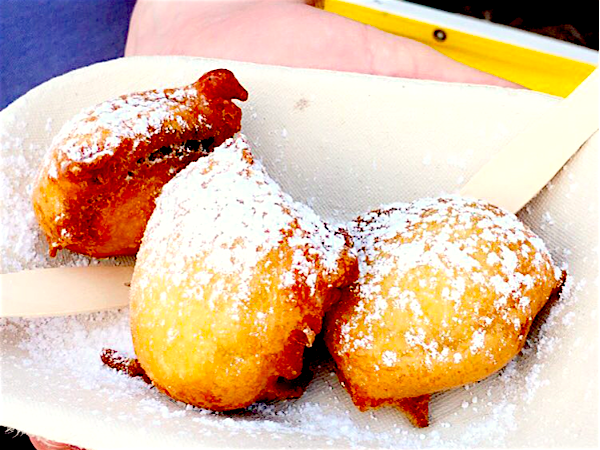 Let’s be honest and forget about beach bodies and being bikini ready in the summer, that’s not what it’s all about. Summer’s all about food, specifically carnival/fair food. All over North America, there’s always a fair or a carnival, with tasty treats that are fried, candied and spun and we’ve got the lowdown on how they came to be.
Let’s be honest and forget about beach bodies and being bikini ready in the summer, that’s not what it’s all about. Summer’s all about food, specifically carnival/fair food. All over North America, there’s always a fair or a carnival, with tasty treats that are fried, candied and spun and we’ve got the lowdown on how they came to be. -
2.
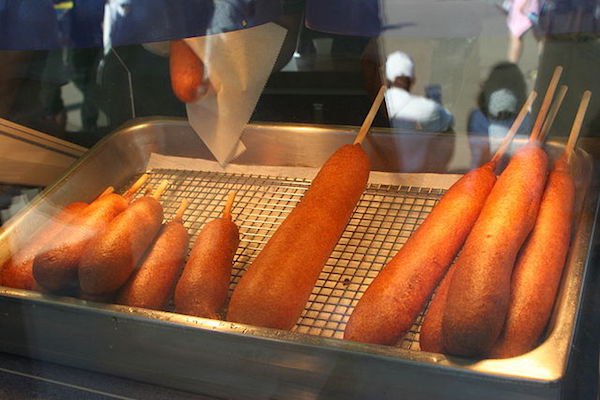 Corn Dogs There’s a lot of people vying for credit for the invention of the Corn Dog. According to some sources, German immigrants arriving in Texas, looking to sell their meat products, found that battering their sausages in a mixture of cornmeal, self-rising flour, eggs and various spices, deep frying it and impaling it on a stick made them more popular. On the other hand, there’s also some sausage and hot dog shops in California, Illinois and Minnesota that lay claim to putting their hotdogs in batter and serving them on a stick. Either way, whoever invented them, they’re awesome with some Dijon mustard.
Corn Dogs There’s a lot of people vying for credit for the invention of the Corn Dog. According to some sources, German immigrants arriving in Texas, looking to sell their meat products, found that battering their sausages in a mixture of cornmeal, self-rising flour, eggs and various spices, deep frying it and impaling it on a stick made them more popular. On the other hand, there’s also some sausage and hot dog shops in California, Illinois and Minnesota that lay claim to putting their hotdogs in batter and serving them on a stick. Either way, whoever invented them, they’re awesome with some Dijon mustard. -
3.
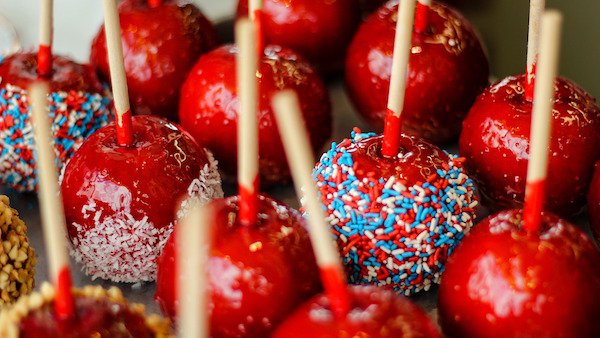 Candy Apples The history on this one is a little backwards; instead of using the candy to entice people to eat more fruit, it was actually using the fruit to get people to eat candy. In 1908, William Kolb of New Jersey, wanted to get people to try his cinnamon candy, and he figured coating an apple with it, would get people to but the candy. Much to his surprise, people liked both and now variations of the concept are all over the world, but the most popular is still the fire engine red candy on a red apple.
Candy Apples The history on this one is a little backwards; instead of using the candy to entice people to eat more fruit, it was actually using the fruit to get people to eat candy. In 1908, William Kolb of New Jersey, wanted to get people to try his cinnamon candy, and he figured coating an apple with it, would get people to but the candy. Much to his surprise, people liked both and now variations of the concept are all over the world, but the most popular is still the fire engine red candy on a red apple. -
4.
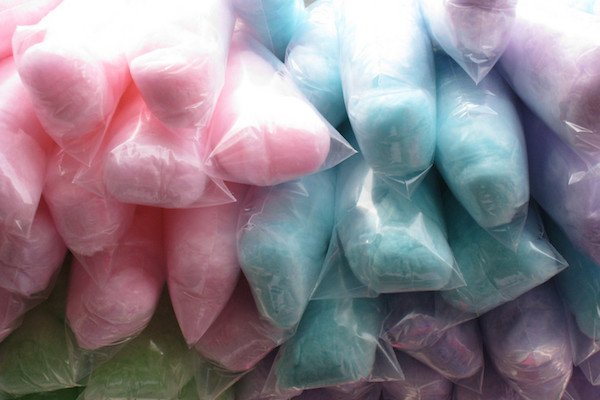 Cotton Candy Bet you didn’t know that the most common attribution for the creation of Cotton Candy was to a dentist? Forms of spun candy have existed since the 15th century, but machine-spun Cotton Candy (where finely ground sugar melted and spun in a large centrifuge with holes to create fine threads of sweetness) was brought to the 1904 Worlds Fair in St. Louis by dentist William Morrison and candy maker John C. Wharton. Selling it at 25 cents a box, they ended up making a fortune, selling over 69 thousand boxes. That’s how popular it was. Now you can find the treat at circuses, fairs and even pre-packaged versions at the grocery store. Such a simple treat, but so delicious.
Cotton Candy Bet you didn’t know that the most common attribution for the creation of Cotton Candy was to a dentist? Forms of spun candy have existed since the 15th century, but machine-spun Cotton Candy (where finely ground sugar melted and spun in a large centrifuge with holes to create fine threads of sweetness) was brought to the 1904 Worlds Fair in St. Louis by dentist William Morrison and candy maker John C. Wharton. Selling it at 25 cents a box, they ended up making a fortune, selling over 69 thousand boxes. That’s how popular it was. Now you can find the treat at circuses, fairs and even pre-packaged versions at the grocery store. Such a simple treat, but so delicious. -
5.
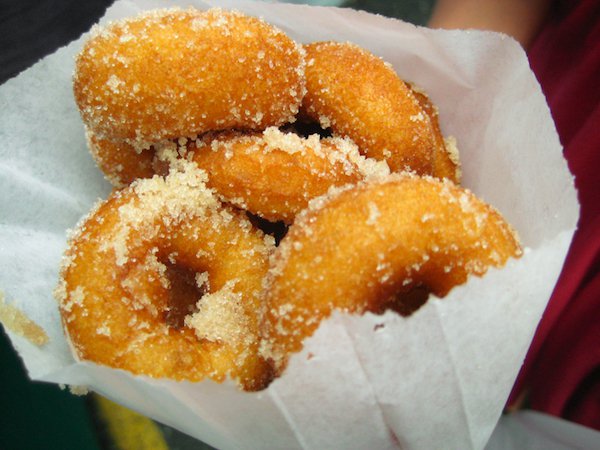 Mini Donuts The origins of who invented the donut are varied, as there are multiple influences all over the world. The most commonly accepted history is that dutch settlers brought over little mini dough cakes that they filled with cremes and preserves, and fried. Keep in mind, these were whole cakes. Apparently a sea captain, tired of how greasy they were and occasionally finding an uncooked centre, started punching a hole in the middle. There’s also an anecdote that claims he put a hole so he could rest the donut on a peg on his ships wheel, for ease of eating. When it comes to the mini donut, apparently during the Spanish-American war in the 1890’s, to better ration the food, mini donuts were distributed to the soldiers. From there, machines were invented to make the mini donuts quickly and this popular treat became synonymous with carnivals, especially when dusted with cinnamon and sugar.
Mini Donuts The origins of who invented the donut are varied, as there are multiple influences all over the world. The most commonly accepted history is that dutch settlers brought over little mini dough cakes that they filled with cremes and preserves, and fried. Keep in mind, these were whole cakes. Apparently a sea captain, tired of how greasy they were and occasionally finding an uncooked centre, started punching a hole in the middle. There’s also an anecdote that claims he put a hole so he could rest the donut on a peg on his ships wheel, for ease of eating. When it comes to the mini donut, apparently during the Spanish-American war in the 1890’s, to better ration the food, mini donuts were distributed to the soldiers. From there, machines were invented to make the mini donuts quickly and this popular treat became synonymous with carnivals, especially when dusted with cinnamon and sugar. -
6.
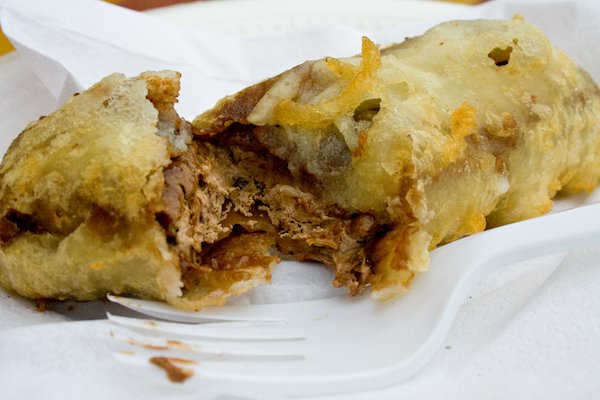 Deep Fried Mars Bar The origins of the deep fried Mars bar are a little vague, but the general understanding that it originated in Scotland, at a Fish & Chip shop. The earliest mentions of the treat were in the 1990’s, when media outlets would report on the notoriously unhealthy diets of the Scottish population, due to their preference to deep fry a lot of things. The owners of the Haven/Carron Chip Bar used to deep fry the bars as a treat for local kids, and it caught on all over Scotland. Once it got some mainstream coverage, the idea of deep frying chocolate bars (and cookies, Cola, and god knows what else) took hold in North America and became a carnival staple all over.
Deep Fried Mars Bar The origins of the deep fried Mars bar are a little vague, but the general understanding that it originated in Scotland, at a Fish & Chip shop. The earliest mentions of the treat were in the 1990’s, when media outlets would report on the notoriously unhealthy diets of the Scottish population, due to their preference to deep fry a lot of things. The owners of the Haven/Carron Chip Bar used to deep fry the bars as a treat for local kids, and it caught on all over Scotland. Once it got some mainstream coverage, the idea of deep frying chocolate bars (and cookies, Cola, and god knows what else) took hold in North America and became a carnival staple all over. -
7.
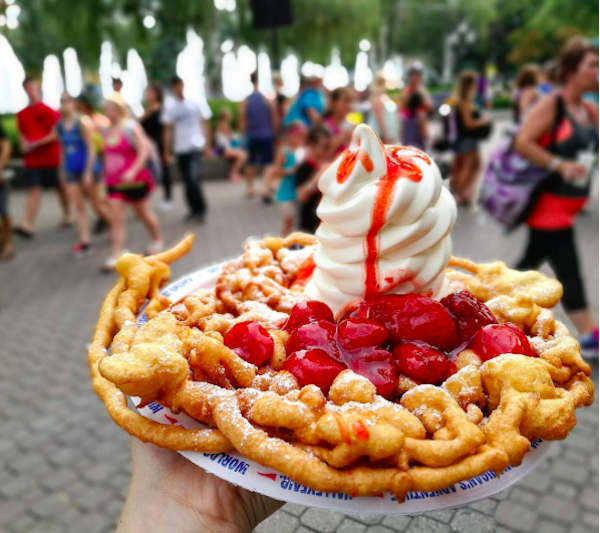 Funnel Cake The concept of the Funnel Cake dates back to early medieval Arabic and Persian cultures, where a similar dough was excreted through a funnel into hot oil to create a lattice, and cooked. Later on, German immigrants brought over the concept in the 1800’s, using the more common baking soda dough and garnishing it with fruit. Now, we devour it, covered in strawberry sauce and soft serve. It’s a very share-able treat, but I don’t know how many people actually do. It’s too good to share.
Funnel Cake The concept of the Funnel Cake dates back to early medieval Arabic and Persian cultures, where a similar dough was excreted through a funnel into hot oil to create a lattice, and cooked. Later on, German immigrants brought over the concept in the 1800’s, using the more common baking soda dough and garnishing it with fruit. Now, we devour it, covered in strawberry sauce and soft serve. It’s a very share-able treat, but I don’t know how many people actually do. It’s too good to share. -
8.
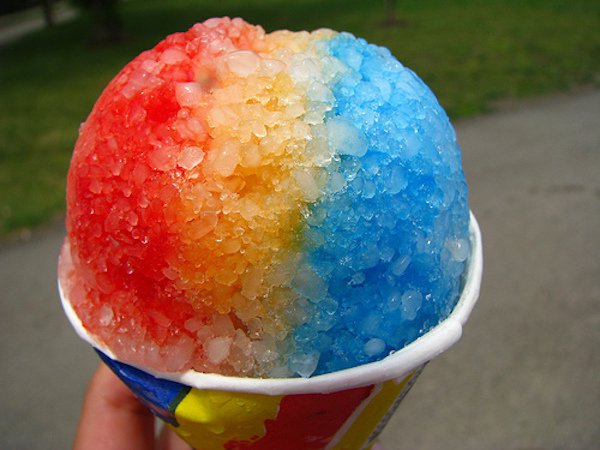 The Sno-Cone How can you go wrong with ice and sugar syrup? This idea is so simple, and so delicious. One of the earliest examples of a snow cone was during the Industrial Revolution, when ice houses in New York would ship ice in trucks, all the way to Florida. Somewhere near Baltimore, apparently, the trucks would stop and kids would ask for ice shavings. Mothers would then create simple syrups and egg custards to add on top of the shavings. From there, mechanical ice shavers were made and by 1920, the first machine was invented (as it was a cheap treat for the Great Depression) and the concept of the Sno-Cone was born. It took off from there. Now you can find variations all over the world, including the ever-popular Slurpee.
The Sno-Cone How can you go wrong with ice and sugar syrup? This idea is so simple, and so delicious. One of the earliest examples of a snow cone was during the Industrial Revolution, when ice houses in New York would ship ice in trucks, all the way to Florida. Somewhere near Baltimore, apparently, the trucks would stop and kids would ask for ice shavings. Mothers would then create simple syrups and egg custards to add on top of the shavings. From there, mechanical ice shavers were made and by 1920, the first machine was invented (as it was a cheap treat for the Great Depression) and the concept of the Sno-Cone was born. It took off from there. Now you can find variations all over the world, including the ever-popular Slurpee. -
9.
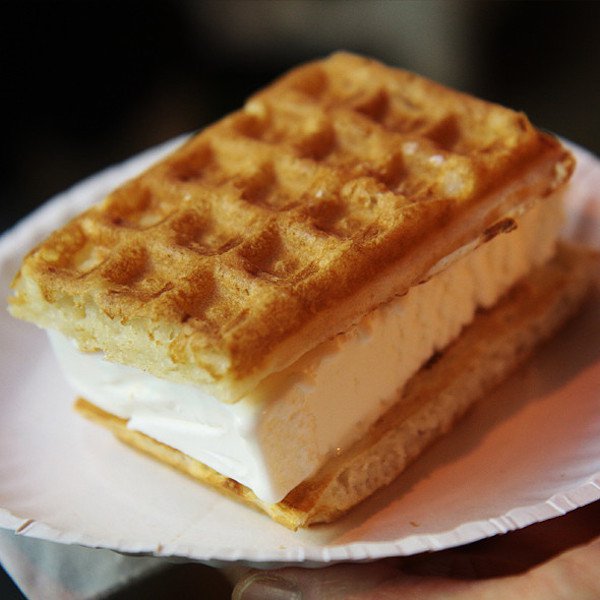 The Hot Ice Cream Waffle This one’s pretty specific, and unique to Toronto. The concept of an ice cream sandwich is old hat, and I don’t think anyone can really lay claim to making the first ice cream sandwich. When it comes to the specific combination of Vanilla ice cream and crispy waffle that you can find at the CNE and PNE, however, it’s the brainchild of Sherole Levan, of Conklin Entertainment; the long time purveyor of midway rides and treats. According to local legend, she brought the combination to The Ex and it’s been one of the most popular treat there ever since. It’s been around for 76 years now, and so far, it’s still the best seller at each year’s exhibition. So what are you waiting for? Go pig out!
The Hot Ice Cream Waffle This one’s pretty specific, and unique to Toronto. The concept of an ice cream sandwich is old hat, and I don’t think anyone can really lay claim to making the first ice cream sandwich. When it comes to the specific combination of Vanilla ice cream and crispy waffle that you can find at the CNE and PNE, however, it’s the brainchild of Sherole Levan, of Conklin Entertainment; the long time purveyor of midway rides and treats. According to local legend, she brought the combination to The Ex and it’s been one of the most popular treat there ever since. It’s been around for 76 years now, and so far, it’s still the best seller at each year’s exhibition. So what are you waiting for? Go pig out! -
10.
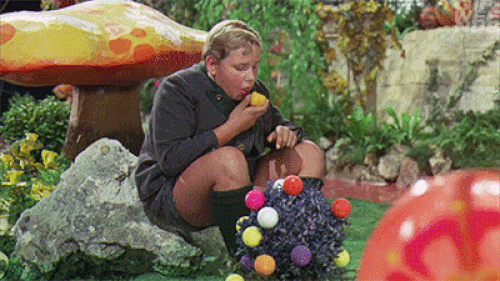
- NEXT GALLERY
-

- 41 Awesomly Sly Pics To Satisfy The Gamer In You
Let’s be honest and forget about beach bodies and being bikini ready in the summer, that’s not what it’s all about. Summer’s all about food, specifically carnival/fair food. All over North America, there’s always a fair or a carnival, with tasty treats that are fried, candied and spun and we’ve got the lowdown on how they came to be.
10/10
1/10
Categories:
Ftw


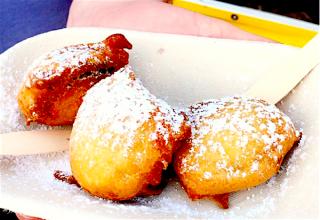
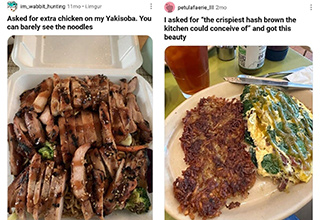




0 Comments